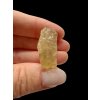Libyan desert glass with sand inclusions – 6,6g
Locality: Eastern Sahara, Libya
Weight: 6,6g
Dimensions: 2,6 x 2,1 x 1,1 cm
| Category: | Libyan desert glass |
|---|
Libyan Desert Glass – a mysterious gift from the desert
Libyan Desert Glass is a rare natural material found in the area of the Great Sand Sea on the border between Egypt and Libya. This unique glass has an exceptionally high silica content (up to 98%) and is considered one of the purest forms of natural glass in the world. Its color ranges from transparent yellow to bright greenish-yellow shades.
Origin
Libyan Desert Glass formed about 26–29 million years ago. Its exact origin remains debated. The most accepted theory suggests it was created by the impact of a meteorite that caused the melting and solidification of surface rocks. Another hypothesis points to an atmospheric explosion (airburst) that generated extreme heat without leaving an impact crater.
Historical and cultural significance
Libyan Desert Glass was already known in ancient Egypt. One of the most famous artifacts made from this material is a scarab set into the necklace of Pharaoh Tutankhamun. This necklace, discovered in his tomb, is considered a unique historical treasure and a testament to the high value Egyptians placed on this rare stone.
Uses
Jewelry: Thanks to its unique color and high purity, Libyan Desert Glass is a popular material for necklaces, rings, and pendants. Its mysterious origin and unusual appearance give it great aesthetic value.
Collecting: Collectors of minerals and tektites value Libyan Desert Glass for its rarity and connection to ancient history. Each piece represents a unique fragment of Earth’s history.
Science: Geologists and planetary scientists study Libyan Desert Glass to better understand impact processes and high-temperature events associated with meteorite impacts. It is not only a beautiful mineral but also a key to understanding the planet’s past.








